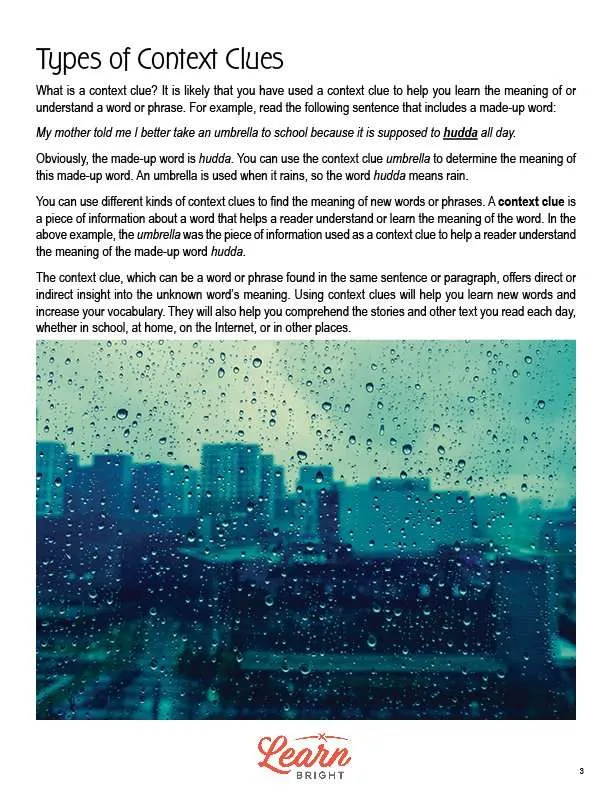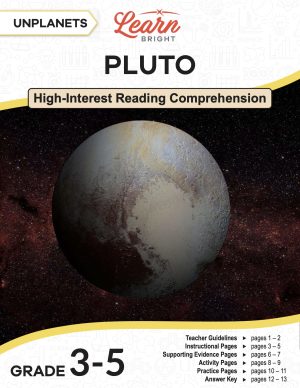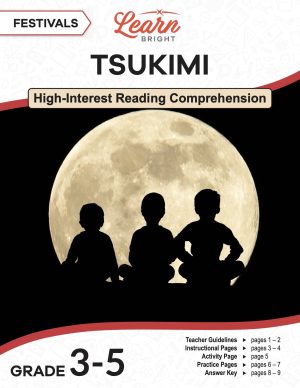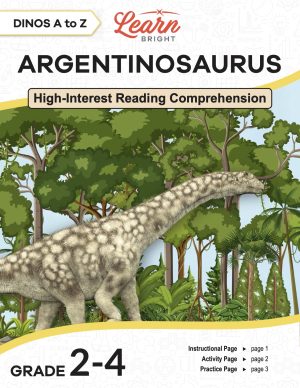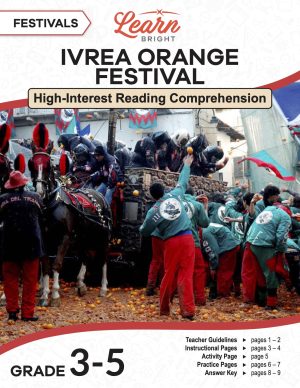Description
What our Contextual Clues lesson plan includes
Lesson Objectives and Overview: Contextual Clues teaches students how to more effectively use context to determine the meaning of a word. At the end of the lesson, students will be able to use context (e.g., definitions, examples, or restatements in text) as a clue to the meaning of a word or phrase. This lesson is for students in 4th grade.
Classroom Procedure
Every lesson plan provides you with a classroom procedure page that outlines a step-by-step guide to follow. You do not have to follow the guide exactly. The guide helps you organize the lesson and details when to hand out worksheets. It also lists information in the green box that you might find useful. You will find the lesson objectives, state standards, and number of class sessions the lesson should take to complete in this area. In addition, it describes the supplies you will need as well as what and how you need to prepare beforehand. The supplies you will need for this lesson are dictionaries and the handouts. To prepare for this lesson ahead of time, you can gather the dictionaries and copy the handouts.
Options for Lesson
Included with this lesson is an “Options for Lesson” section that lists a number of suggestions for activities to add to the lesson or substitutions for the ones already in the lesson. One optional addition to this lesson is to use current reading material throughout the lesson, having students discover the meaning of unknown words in the material using context clues. One adjustment to the lesson activity if to have students choose words on their own and then exchange their sentences with another student to determine the meaning of each word.
Teacher Notes
The teacher notes page includes a paragraph with additional guidelines and things to think about as you begin to plan your lesson. This page also includes lines that you can use to add your own notes as you’re preparing for this lesson.
CONTEXTUAL CLUES LESSON PLAN CONTENT PAGES
Types of Context Clues
The Contextual Clues lesson plan includes three pages of content. The lesson begins by explaining that students have likely used context clues before to help them understand the meaning of a word or phrase. It’s a piece of information about a word that helps the reader understand or learn the meaning of that word. The lesson includes an example with a made-up word and describes how to use context clues to figure out the meaning.
Context clues give direct or indirect insight into a word’s meaning. You can find them in the same sentence or paragraph as the unknown word. Learning how to use context clues will help you learn new words, increasing your vocabulary. In turn, you will be able to better understand the stories and texts you read at home and at school.
Types of Context Clues
We have several different kinds of context clues, which the lesson lists in a helpful chart. Each type includes an example. The first type are definitions, which are the easiest to identify. The definition typically follows the word, and signal words or clues for this type include is and means.
The second type are examples. With this type, you’ll see an example of the unknown word in the sentence. Some signal words for this type of context clue are such as, these, other, include, and for example. The third type are restatements, where the unknown word is restated using a different word or phrase. Signal words for this type include or, that is, in other words, and which is.
The fourth type are cause/effect relationship. With this type, the sentence will include a cause and effect relationship that tells you the meaning. Clue words for this type include because, so that, and in order to. Finally, the fifth type are comparisons. These can include synonyms or antonyms, and some clue words include like, unlike, but, not, in contrast to, similar to, and in the same way.
The examples for each of these types of context clues show how each of these can lead you to the definition of an unknown word. Sometimes, you might be able to figure out the general meaning of a word, but not the exact meaning.
Using Contextual Clues
If you’re reading and find a word that you don’t know, you will first need to reread the sentence to find some context clues. You should also reread the sentences before and after the sentence with the unknown word. The lesson includes an example with the unknown word chronological. In this example, the next sentence tells you that they watched movies from the beginning to the end, which tells you that they watched them in order. Therefore, you can figure out that the word chronological means in order.
The lesson closes with a few more examples that describe how to use different types of context clues to figure out the meaning of a word or phrase. You should try to use context clues to find the meaning before you look a word up in the dictionary. Using context clues will help you become a better reader with a larger vocabulary and increased reading comprehension!
CONTEXTUAL CLUES LESSON PLAN WORKSHEETS
The Contextual Clues lesson plan includes three worksheets: an activity worksheet, a practice worksheet, and a homework assignment. You can refer to the guide on the classroom procedure page to determine when to hand out each worksheet.
DICTIONARY ACTIVITY WORKSHEET
For the activity worksheet, students will use a dictionary to define five words. They will then create one or two sentences using each word that include context clues so that another person can figure out the meaning of that word using their sentence(s).
Students can work in pairs or groups to complete this activity if you’d like.
FIND THE MEANING PRACTICE WORKSHEET
The practice worksheet asks students to complete two short exercises. For the first, they will read sentences and use context clues to match the bolded word in each sentence with the correct definition. For the second, they will reach each sentence and use context to figure out the meaning of each underlined word. They will then explain what clues in the sentences allowed them to determine the meaning.
CONTEXTUAL CLUES HOMEWORK ASSIGNMENT
For the homework assignment, students will first look at the underlined context clues in each sentence and will circle the word connect to each definition, writing the definition of the word or phrase as well. They will then read short passages from Rapunzel. They will determine the meaning of each bolded word in the passages.
Worksheet Answer Keys
This lesson plan includes answer keys for the activity worksheet, the practice worksheet, and the homework assignment. If you choose to administer the lesson pages to your students via PDF, you will need to save a new file that omits these pages. Otherwise, you can simply print out the applicable pages and keep these as reference for yourself when grading assignments.


